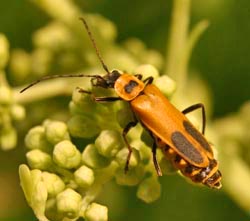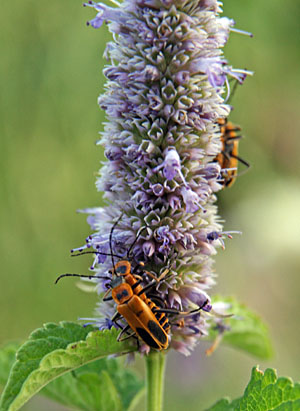
There many species of soldier beetles (family Cantharidae) in North America. These elongate insects have soft, flexible elytra (wing covers) and resemble fireflies, but do not have light-producing organs. Goldenrod soldier beetle or Pennsylvania leatherwing (Chauliognathus pensylvanicus) is one of the most common species of soldier beetle in the Midwest. These 5/8-inch long, orange beetles, with two prominent brown-black spots on the elytra,

often are seen on goldenrod flowers – hence the common name – but they will also visit many other flowers, including yellow composites, Queen Anne’s lace (Daucus carota), milkweed, rattlesnake master (Eryngium yuccifolium) and other late-summer flowering plants.
Adults may be seen from July to September but are most abundant in August. They can be found in meadows, fields and in gardens. They feed primarily on pollen and nectar of flowers but may also eat small insects such as caterpillars,

eggs and aphids. The flowers are also a meeting place for finding mates. They do no damage to the plants and do not bite or sting. These insects may be accidental invaders in homes, but generally do not require control outdoors. Caulking and other measures to prevent entry is the best means of reducing problems; any inside the house can be swept, picked up, or vacuumed up.

Adult females lay their eggs in clusters in the soil. The dark-colored, long, slender, worm-like larvae are covered with tiny dense bristles, giving a velvety appearance. They spend their time in the soil, where they are are predators of other insects, eating grasshopper eggs, small caterpillars and other soft-bodied insects.
The similar margined soldier beetle (C. marginatus) is active in May and June. It is a darker orange color and the markings on the elytra vary from no spot to a continuous dark streak along the entire length of the wing cover.
– Susan Mahr, University of Wisconsin – Madison
Latest Horticulture News
Ask Your Gardening Question
If you’re unable to find the information you need, please submit your gardening question here:





 Alternatives to Lawn: Groundcovers
Alternatives to Lawn: Groundcovers Marigolds
Marigolds Peony
Peony Iris Severe Mosaic
Iris Severe Mosaic


